×


We have detected your country as:
Please click here to go to the USA website or select another country from the dropdown list.
by: Rev. Rebecca J. Brimmer, International President and CEO
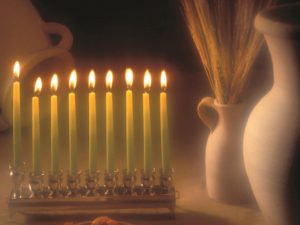
www.israelimages.com/Flavio Sklar
Last month, we began our look at Israel’s annual celebrations, some biblical, some traditional, and some secular. We started with Purim (Feast of Esther), which usually takes place in March, and ended with Shavuot (Pentecost). In this Teaching Letter, we will complete the year’s cycle of remembrances.
During the Six Day War in June of 1967, the city of Jerusalem was reunited under Israeli sovereignty. Every year on the anniversary of this victory (Iyar 28 on the Hebrew calendar), the city of Jerusalem rejoices with a joyous parade. As far as one can see are Israeli flags held by dancing, rejoicing people, most of whom are dressed in blue and white (the colors of Israel).
Many Bible teachers have suggested that June 1967 was the end of “the times of the Gentiles” (Luke 21:24), as the Gentile domination of Jerusalem came to an end, and once again Israel was in full sovereignty over the city of Jerusalem.
Leviticus 23:23–25
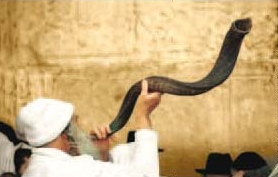
www.israelimages.com/Michael Levit
The fall holidays, or High Holy Days, begin with the celebration of Rosh HaShanah (the Jewish New Year), which in Hebrew means “head of the year.” It is also known as the Feast of Trumpets and Day of the Blowing (Yom HaTeruah). The shofar (ram’s horn) is blown all over the Land on this day, which marks the beginning of the holiest time of year on the Jewish calendar. The 10 days between Rosh HaShanah and Yom Kippur (Day of Atonement) are called the 10 Days of Awe. These 10 days are a time of introspection, a time of searching your soul, a time to make everything right between you and your God, as well as your fellow man.
One of my first memories of Rosh HaShanah happened in 1987. My husband Tom and I were preparing to come to Israel. We had applied to be volunteers on a kibbutz, and one of the requirements for acceptance to the program was a recommendation letter from our local rabbi. Since we are Christians, we didn’t have a rabbi. However, in our desire to learn more about our Hebraic roots, we had attended Hebrew classes at the local Reform synagogue. The local rabbi’s daughter had taught the classes. Unfortunately, just a couple of months previously, the rabbi had passed away, and we did not have a relationship with the new rabbi. Still, it was a requirement, and we really wanted to be a part of this program.
So, we went to visit the new rabbi and become acquainted, just a week or so before Rosh HaShanah. We didn’t have much time as we were to leave for Israel on a tour in October, and it was already September. So, after a very short relationship, we asked the new rabbi for a letter of recommendation during the 10 Days of Awe. Because he wanted to keep himself in right relationship with God and his fellow man and did not want to do anything to hinder this relationship, he very graciously gave us the needed letter. We probably could not have asked at a better time. God was obviously paving the way for us.
Secular New Year’s Day (January 1) celebrations in the West are marked by partying, drinking, and merrymaking. In contrast, Rosh HaShanah is a much more solemn time, described by some as subdued joyousness. It begins a season for solemn evaluation and inward scrutiny. The Bible describes the month of Nisan as the first month of the year (usually around April), yet for 2,000 years, the Jewish people have been celebrating their New Year at Rosh HaShanah in the Hebrew month of Tishri (usually around September).
Why is this? Arthur Waskow, in his book Seasons of Our Joy, describes it as “the month of early fall, of catching our breath after the hot, dry winds of summer. Because it is the seventh month, it echoes the seventh day, the Shabbat (Sabbath) of rest and contemplation, of catching our breath after six days of hard work. So perhaps Rosh HaShanah is the new year for renewal. Like Shabbat, it is the time to focus our attention on ultimate spiritual truth. This is then the new year for learning how a human being can turn toward God.”
I like that thought. As I hear the sounds of the shofar at Rosh HaShanah, I reflect on these thoughts and feel at one with the Jewish people. I find myself examining my heart to see if there is anything I need to correct. Are there relationships that need mending? What is God speaking to me about? What do I need to concentrate on to become the woman that God has planned me to be? Many people write New Year’s resolutions on January 1. My experience with these resolutions is that they are quickly forgotten. However, the self-assessment that I make at Rosh HaShanah and in the days leading up to Yom Kippur are more long lasting. It is a special appointment that I look forward to each year.
As with all Jewish holidays, there are special foods eaten on this day, which are symbolic. Sweet foods are eaten, usually apples dipped in honey, to indicate the desire for a sweet year. Round foods are eaten to symbolize the cycle of the year. There is always an abundance of food, indicative of a hope for fruit and prosperity. Fish, cooked with the head left on, is often the main course, symbolizing the head of the year.
I hope that I have whetted your appetite to experience Rosh HaShanah for yourselves. If so, find time to search your heart, make things right with your fellow man, and celebrate with your friends and family. I greet you as my Israeli friends greet each other on this day: “L’shanah tovah tichatevu” (May you be inscribed for a good year), a desire for our names to be written in the Book of Life.
Leviticus 23:26–32
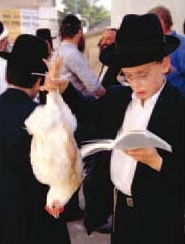
www.israelimages.com/Sammy Avnisan
Yom Kippur is the most holy day of the year in Israel. In English Bibles, it is called the Day of Atonement. It is sometimes called the Shabbat of Shabbats. This is the day when the High Priest in biblical times entered the Holy of Holies to seek forgiveness of sins for himself and the nation. It is a day when Jews seek forgiveness from God. The synagogues are full of worshippers. It is a day of complete fasting from food and water. The vast majority of the country participates, with over 80% fasting. This is fascinating, given that at least 50% of the population consider themselves secular. In fact, persons who observe little or nothing of their Jewish heritage year-round often attend a synagogue on this day.
I love the way Pam Edwards, Bridges for Peace representative in Oklahoma, US, described her first experience with Yom Kippur: “My first exposure to how the Jewish people celebrate was during my first visit to Israel. It was September 1999. I had been in Israel only a few days. My husband and I and a couple of friends were ready for a fun evening out for dinner and shopping, only to find the entire city of Jerusalem closed. The shops, restaurants, taxis, even the airport. Can you imagine?!
I was thinking ‘Twilight Zone’…They call it Yom Kippur. What a fascinating concept…that people actually take an entire day off from working and buying stuff to reflect on their lives, talk to God, seek forgiveness, and stay home with their own family. This so fascinated and intrigued me, I had to learn more. Well, imagine my surprise when the first Shabbat rolled around, and it was the same thing all over again. Who are these people?!
A people so dedicated to their God and country and heritage that they are willing to set aside a full day every week to honor and pay tribute. Thus began my love affair with a people and a nation.”
Yom Kippur is holy to God as well. In Leviticus 23:26–32, we find, “The tenth day of this seventh month is the Day of Atonement. Hold a sacred assembly and deny yourselves…” Three times in these verses the children of Israel are commanded to deny themselves. The most common interpretation for this (in Israel) is to fast from food and water.
It is a source of amazement to me that nearly the entire Jewish population of Israel does just that. Often in Christian circles, I have heard people say how hard it is to fast. When they say this, they are talking of fasting from food. I can tell you from experience that fasting from food for a day is easy compared to fasting from water and all other liquids as well. However, just before the fast begins, a large meal is eaten, and as soon as the fast is completed, another meal is quickly prepared for everyone is very hungry.
The nation of Israel stops for 25 hours (from an hour before sundown to sundown the next day). The streets are empty, as everyone stays home and virtually no one—except Arabs—drives a car anywhere unless it is an absolute emergency. Children and teens take advantage of this fact and rollerblade, ride their bikes, and walk in the middle of the streets—the only day of the year when such a thing is possible.
Every year, my husband and I join in this time of fasting, prayer, and self-assessment. As we contemplate and seek the Lord, He will often shine His light into our hearts, and suddenly we find things we need to repent of. Obviously, we should repent of our sins on a daily basis, but Yom Kippur is a special day of repentance. We gather with friends and pray for Israel, repent of our sins, and seek the face of God for the coming year. It is not an easy day, but it is a good day, which we have set aside to join our hearts with the Jewish people.
Leviticus 23:33–43
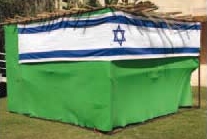
www.israelimages/Iral Tal
Sukkot is a happy holiday on the Jewish calendar. Literally, sukkot means “booths.” The holiday commemorates the 3,500-year-old journey of the Israelites with Moses from slavery in ancient Egypt to freedom in the Land of Israel. They wandered in the desert for 40 years, living in temporary booths, and for generations now, it has been the custom to build a sukkah, in accordance with the biblical injunction, outside the house, in the yard, or on a balcony.
A sukkah can be made with a simple square frame of wood or metal. Sheets, rugs, or blankets are hung to form the walls of the sukkah, and palm branches are placed on top as the roof, with spaces left to allow the stars to be seen. The booth is big enough to accommodate a table, as the family eats its meals in the booth during the seven days of the holiday. Families join together in building the sukkah and decorating it with pictures, handicrafts, flowers, and fresh fruits hanging from the palm branch roof. It is used as often as possible during the week: sitting, talking, eating, singing, and entertaining friends. Some families even sleep in the sukkah. At night, the air is somewhat chilly and crisp, and the menu is planned around dishes that will reach the table while still hot.
Not only is the meal eaten together, but the Exodus story is retold or read from the Bible, songs are sung, and great joy is shared while remembering God’s provision of food and shelter for 40 years. All of these activities remind them of their transition from slavery to freedom. The flimsiness of the dwelling equalizes all men because everyone is on the same level during this week. It also reminds those inside that they are but frail creatures in need of God’s protection and provision.
Sukkot, the third pilgrimage holiday, coincides with the end of the fruit harvest. In ancient Israel, farmers went up to Jerusalem and brought gifts of their crops to God at the Temple.
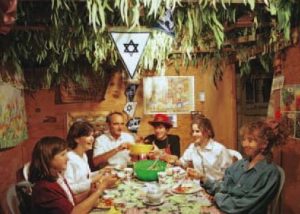
www.israelimages.com/Karen Benzian
The Feast of Tabernacles, the most joyous of the three pilgrimage festivals, is concluded with a special day called Simchat Torah. On this day, the annual Torah (Gen.–Deut.) reading cycle, which throughout the year is read each week portion by portion, is completed. As soon as the last word of Deuteronomy is read, the scroll is rolled back to the beginning, and the first verses of Genesis are read to show that the study of the Torah is never ending.
On this special day, you can walk into synagogues around the world and find a joyous scene. All the scrolls of the Torah are taken from the ark, an ornate cabinet, and carried in procession around the synagogue seven times. The actual carrying is shared by all congregants. Even in synagogues where the women are traditionally segregated, on Simchat Torah, they are welcomed into the main sanctuary to touch and kiss the Torah scrolls. During the procession, happy songs of praise are sung, and congregants dance with the scrolls while children wave Torah-decorated flags, which sometimes have an apple impaled on the flagpole and a candle burning in the apple.
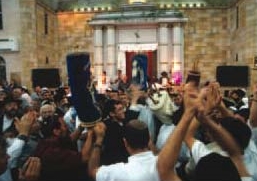
www.israelimages.com/Hanan Isachar
The Torah reading is also shared by all eligible adults. Even the children are encouraged to come up and read from the Torah. This synagogue service is one of the happiest and most raucous of the entire year. The joyous procession usually continues outside into the streets surrounding the synagogue, where observers typically get caught up in the merriment and join the dancing and singing.
In the 1960s, Simchat Torah was discovered by Russian Jewish students. The Jews of Russia, who had been forbidden to practice their religion in any way, suddenly began to dance in the streets of Moscow and Leningrad in the areas around the synagogues. It was an opportunity to affirm and celebrate their Jewishness in public. The Western press and visitors were drawn to these gatherings. The celebrations came to symbolize the desire and right of Soviet Jews to live as Jews openly or to leave the Soviet Union. They electrified Jewish communities around the world, who formed Simchat Torah rallies, marches, and street dances in solidarity with their Soviet Jewish brethren.
A visitor to Leningrad, in those heady days, described the experience as follows: “What surprised me the most was that there were thousands and thousands of people—they just kept coming and coming—who knew the Jewish songs and dances. Somehow the music had been kept in their families, even though they didn’t practice Judaism or ever attend a synagogue.” Now many of those Russian Jewish students are celebrating Simchat Torah in their ancient and new homeland, Israel.
John 10:22
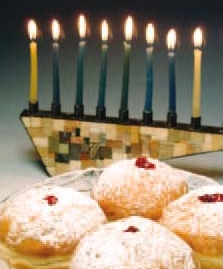
www.israelimages.com/Raffi Rondel
During the time between the end of the Old Testament and the beginning of the New Testament, there was a struggle between Hellenism and Hebraic practice in Israel. Many began to seem more Greek than Hebrew, forsaking the ways of God for the ways of their “modern” world. But, many God-fearing Jews refused. A family, called the Maccabees, led the struggle against Hellenism and the Greek rulers of their day. Miraculously, they were victorious against much stronger forces. Following the victory, they went to rededicate the Temple, which had been desecrated by the sacrifice of pigs the altar. Sadly, they only found one vessel of consecrated anointing oil for the Temple menorah. The story goes that the one vessel lasted for eight days, the time it took to prepare more oil. Thus, Hanukkah is an eight-day celebration to commemorate the miracle of oil. Deep-fried foods are eaten, like potato pancakes (latkes) and caramel- or jelly-filled doughnuts (sufganiot).
Children and adults alike play a game called dreidels. A dreidel is a four-sided top with four Hebrew letters standing for the words, “a great miracle happened here” if you are in Israel or “a great miracle happened there” if you are outside Israel. Each player is given an equal number of candies (often the gold-covered chocolate “coins” sold in small net bags) with a “pot” in the center. At each spin, players either win nothing, everything, half of the pot, or have to give up one of their coins. The game ends when one player wins everything. In some families, if real money is used, the winning player gives all the money for charity.
So, you can see that there are a lot of special days in Israel’s yearly calendar. As you enjoy them, please remember to thank God for all He has done for Israel and also for you and your family. Let us testify to the goodness of God.
“Oh, give thanks to the LORD! Call upon His name; make known His deeds among the peoples! Sing to Him, sing psalms to Him; talk of all His wondrous works! Glory in His holy name; let the hearts of those rejoice who seek the LORD! Seek the LORD and His strength; seek His face evermore! Remember His
marvelous works which He has done,
His wonders, and the judgments of His mouth” (Psalm 105:1–5).
By Rebecca J. Brimmer
International President and CEO
For more information on Jerusalem, order our new book (see ad below)
and read Chapter 11, “The Significance of Jerusalem” by John Anthony.
Israel and the Church: God’s Road Map,
an anthology written by Rebecca J. Brimmer and several
Bridges for Peace leaders around the world. Chapters include
“Living in the Days of the Bible”
“Did God Break His Covenant with the Jews?”
“Aliyah: The Return to Zion”
“From Jewish Movement to Gentile Church”
“Replacement Theology”
Order your copy now.
All logos and trademarks in this site are property of their respective owner. All other materials are property of Bridges for Peace. Copyright © 2024.
Website Site Design by J-Town Internet Services Ltd. - Based in Jerusalem and Serving the World.